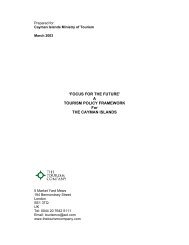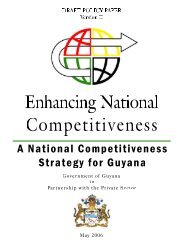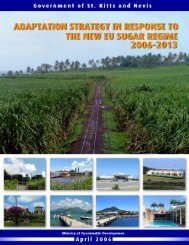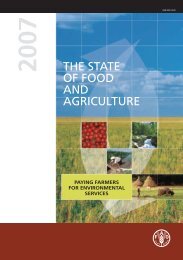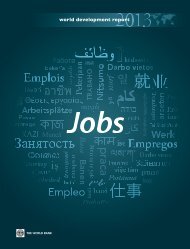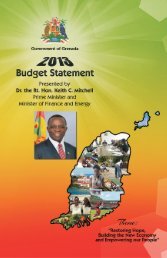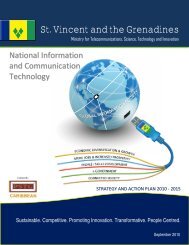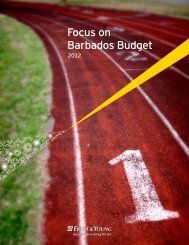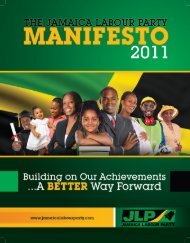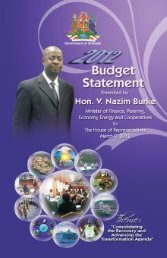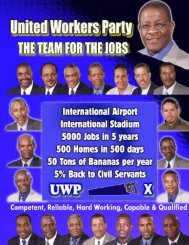Business Removing
Doing Business in 2005 -- Removing Obstacles to Growth
Doing Business in 2005 -- Removing Obstacles to Growth
- No tags were found...
Create successful ePaper yourself
Turn your PDF publications into a flip-book with our unique Google optimized e-Paper software.
80 DOING BUSINESS IN 2005<br />
Economy characteristics<br />
Region and income group<br />
Doing <strong>Business</strong> uses the World Bank regional and income<br />
groupings available at http://www.worldbank.org/data/<br />
countryclass/countryclass.html. Throughout the report, the<br />
term rich economies refers to the high income group, middle<br />
income refers to the upper middle income group and poor<br />
economies refers to the lower middle and low income groups.<br />
Gross National Income (GNI) per capita<br />
Doing <strong>Business</strong> reports 2003 income per capita, calculated<br />
using the Atlas method (current US$), as published in the<br />
World Development Indicators. For cost indicators expressed<br />
as a percentage of income per capita, 2003 local currency unit<br />
GNI, as reported in the World Development Indicators, is<br />
used as the denominator.<br />
Population<br />
Doing <strong>Business</strong> reports mid-year 2003 population statistics as<br />
published in the World Development Indicators.<br />
Starting a business<br />
Doing <strong>Business</strong> records all generic procedures that are officially<br />
required for an entrepreneur to start up an industrial or<br />
commercial business. These include obtaining all necessary<br />
licenses and permits and completing any required notifications,<br />
verifications or inscriptions with relevant authorities.<br />
After a study of laws, regulations, and publicly available information<br />
on business entry, a detailed list of procedures,<br />
time, cost and minimum paid-in capital requirements is developed.<br />
Subsequently, local incorporation lawyers and government<br />
officials complete and verify the data on applicable<br />
procedures, the time and cost of fulfilling each procedure<br />
under normal circumstances and the minimum paid in capital.<br />
On average at least four different law firms participate per<br />
country. Information is also collected on the sequence in<br />
which procedures are to be completed and whether procedures<br />
may be carried out simultaneously. It is assumed that<br />
any required information is readily available and that all government<br />
and nongovernment agencies involved in the startup<br />
process function efficiently and without corruption. If answers<br />
by local experts differ, enquiries continue until the data<br />
are reconciled.<br />
Assumptions about the business<br />
To make the business comparable across countries, 10 assumptions<br />
are employed. The business:<br />
• Is a limited liability company. If there is more than one<br />
type of limited liability company in the country, the most<br />
popular limited liability form among domestic firms is<br />
chosen. Information on the most popular form is obtained<br />
from incorporation lawyers or the statistical office.<br />
• Operates in the country’s most populous city.<br />
• Is 100% domestically owned and has 5 owners, none of<br />
whom is a legal entity.<br />
• Has start-up capital of 10 times income per capita at the<br />
end of 2003, paid in cash.<br />
• Performs general industrial or commercial activities, such<br />
as the production or sale of products or services to the<br />
public. It does not perform activities of foreign trade and<br />
does not handle products subject to a special tax regime,<br />
for example, liquor or tobacco. The business is not using<br />
heavily polluting production processes.<br />
• Leases the commercial plant and offices and is not a proprietor<br />
of real estate.<br />
• Does not qualify for investment incentives or any special<br />
benefits.<br />
• Has up to 50 employees 1 month after the commencement<br />
of operations, all of them nationals.<br />
• Has a turnover at least 100 times income per capita.<br />
• Has a company deed 10 pages long.<br />
Assumptions about procedures<br />
To make the procedures comparable across countries, 6 assumptions<br />
are employed:<br />
• A procedure is defined as any interaction of the company<br />
founder with external parties (government agencies,<br />
lawyers, auditors, notaries). Interactions between company<br />
founders or company officers and employees are not<br />
considered separate procedures.<br />
• The founders complete all procedures themselves, without<br />
middlemen, facilitators, accountants or lawyers, unless the<br />
use of such third party is mandated by law.<br />
• Procedures that are not required by law for starting<br />
a business are ignored. For example, obtaining<br />
exclusive rights over the company name is not counted<br />
in a country where businesses may use a number as identification.<br />
• Shortcuts are counted only if they fulfill 3 criteria: they are<br />
legal; they are available to the general public; and avoiding<br />
them causes substantial delays.<br />
• Only procedures required of all businesses are covered. Industry-specific<br />
procedures are excluded. For example,<br />
procedures to comply with environmental regulations are<br />
included only when they apply to all businesses.<br />
• Procedures that the company undergoes to connect to<br />
electricity, water, gas and waste-disposal services are not<br />
included, unless they entail inspections required prior to<br />
starting operations.



